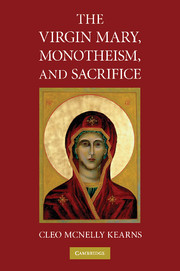Book contents
- Frontmatter
- Contents
- Preface
- Acknowledgments
- Introduction: A Vehement Flame
- PART ONE THEORIES OF SACRIFICE
- PART TWO MARY, MOTHERHOOD, AND SACRIFICE IN THE GOSPELS
- PART THREE MARY AND PRIESTHOOD
- 7 The Order of Melchizedek: Hebrews and Revelation
- 8 Mary, Priesthood, and Paternity in the Protoevangelion and the Qur'an
- 9 Eucharist and Ecclesia: Mary as Temple of the Temple
- Conclusion: Beyond Orthodoxy
- Notes
- Index
7 - The Order of Melchizedek: Hebrews and Revelation
Published online by Cambridge University Press: 27 July 2009
- Frontmatter
- Contents
- Preface
- Acknowledgments
- Introduction: A Vehement Flame
- PART ONE THEORIES OF SACRIFICE
- PART TWO MARY, MOTHERHOOD, AND SACRIFICE IN THE GOSPELS
- PART THREE MARY AND PRIESTHOOD
- 7 The Order of Melchizedek: Hebrews and Revelation
- 8 Mary, Priesthood, and Paternity in the Protoevangelion and the Qur'an
- 9 Eucharist and Ecclesia: Mary as Temple of the Temple
- Conclusion: Beyond Orthodoxy
- Notes
- Index
Summary
“You are a priest for ever according to the order of Melchizedek.”
Psalm 110The Spirit and the bride say, “Come.”
And let everyone who hears say, “Come.”
And let everyone who is thirsty come,
Let anyone who wishes take the water of life as a gift.
Revelation 22:17After the gospels, mary disappears from explicit mention in the New Testament, though she appears at prayer with the other disciples in Acts 1:14. She is found again, however, in a plethora of hymns, sermons, polemics, legends, visual representations, and devotional writings in the emerging Christian church, in the Qur'an, and in Christian and Muslim scriptural and devotional reflections. In the Christian tradition, the pattern formed by her association with the theme of sacrifice begins to take stronger form, based in part on new understandings of the sacrificial work of Jesus on the cross and the institutional embodiment of this work in sacramental life, ecclesiastical order, priestly hierarchy and Eucharistic liturgical practice. Indeed, a whole set of typologies springs up around this association, in which Mary becomes not just the New Abraham and the Daughter of Zion, but the Temple of the Temple and, eventually, according to some ways of seeing her the Mother of the Church.
Mary is linked in these developments to the life of the ancient Israel temple cult, or rather that life as retrospectively conceived in the Christian imaginary.
- Type
- Chapter
- Information
- The Virgin Mary, Monotheism and Sacrifice , pp. 197 - 230Publisher: Cambridge University PressPrint publication year: 2008



